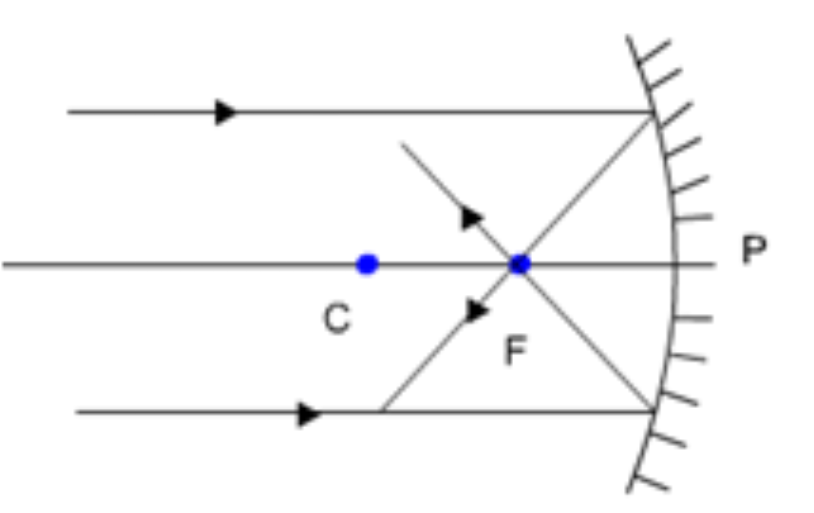
Mirror used by a dental surgeon is
A. Plane
B. Convex
C. Concave
D. Convex and concave
Answer
576k+ views
Hint: A mirror is used by a dental surgeon to see the teeth of a patient by focusing the light rays on the patient’s teeth. This will happen when the tooth of the patient is placed at the focus of the mirror which the doctor is using. For light rays to focus on a particular position, they should reflect through a converging mirror. For the tooth image to appear clearly, the image should be magnified. That means magnification should be greater than 1.
Complete step by step answer:
The mirror used by a dentist to focus light on a patient should be converging because the light rays coming from infinity undergo reflection by the mirror and finally converge at a certain point called focus of the mirror. The tooth of the patient will be placed at this focal point of the mirror. The mirror should also produce some magnification greater than 1. The mirror satisfying both the converging and magnifying properties is only a concave mirror. This reflection concept can be easily explained by the diagram below.

From the above figure, it is clear that the light rays coming from infinity are getting reflected and then after bending, all the rays converge at a point. For concave mirrors, magnification is greater than 1. Hence, the dentist can see a clear, magnified image of the tooth of the patient by using a concave mirror.
So, the correct answer is “Option C”.
Additional Information:
Magnification of a concave mirror is the ratio of the height of the image to the height of the object.
Magnification of a concave mirror formula is given by,
$$m\quad =\quad -\dfrac { v }{ u }$$ where, m refers to magnification
v refers to distance of the image from the mirror
u refers to distance of the object from the mirror
The negative sign means that the image is inverted.
Note:
This question can also be solved by cancelling other options because convex mirrors cannot act as converging mirrors and it is clear from the hint that a dental surgeon will surely require a converging and magnifying mirror. Thus proving our one and only answer as a concave mirror.
Complete step by step answer:
The mirror used by a dentist to focus light on a patient should be converging because the light rays coming from infinity undergo reflection by the mirror and finally converge at a certain point called focus of the mirror. The tooth of the patient will be placed at this focal point of the mirror. The mirror should also produce some magnification greater than 1. The mirror satisfying both the converging and magnifying properties is only a concave mirror. This reflection concept can be easily explained by the diagram below.

From the above figure, it is clear that the light rays coming from infinity are getting reflected and then after bending, all the rays converge at a point. For concave mirrors, magnification is greater than 1. Hence, the dentist can see a clear, magnified image of the tooth of the patient by using a concave mirror.
So, the correct answer is “Option C”.
Additional Information:
Magnification of a concave mirror is the ratio of the height of the image to the height of the object.
Magnification of a concave mirror formula is given by,
$$m\quad =\quad -\dfrac { v }{ u }$$ where, m refers to magnification
v refers to distance of the image from the mirror
u refers to distance of the object from the mirror
The negative sign means that the image is inverted.
Note:
This question can also be solved by cancelling other options because convex mirrors cannot act as converging mirrors and it is clear from the hint that a dental surgeon will surely require a converging and magnifying mirror. Thus proving our one and only answer as a concave mirror.
Recently Updated Pages
A man running at a speed 5 ms is viewed in the side class 12 physics CBSE

State and explain Hardy Weinbergs Principle class 12 biology CBSE

Which of the following statements is wrong a Amnion class 12 biology CBSE

Two Planoconcave lenses 1 and 2 of glass of refractive class 12 physics CBSE

The compound 2 methyl 2 butene on reaction with NaIO4 class 12 chemistry CBSE

Bacterial cell wall is made up of A Cellulose B Hemicellulose class 12 biology CBSE

Trending doubts
What are the major means of transport Explain each class 12 social science CBSE

Which are the Top 10 Largest Countries of the World?

Draw a labelled sketch of the human eye class 12 physics CBSE

Explain sex determination in humans with line diag class 12 biology CBSE

The pH of the pancreatic juice is A 64 B 86 C 120 D class 12 biology CBSE

Give 10 examples of unisexual and bisexual flowers




